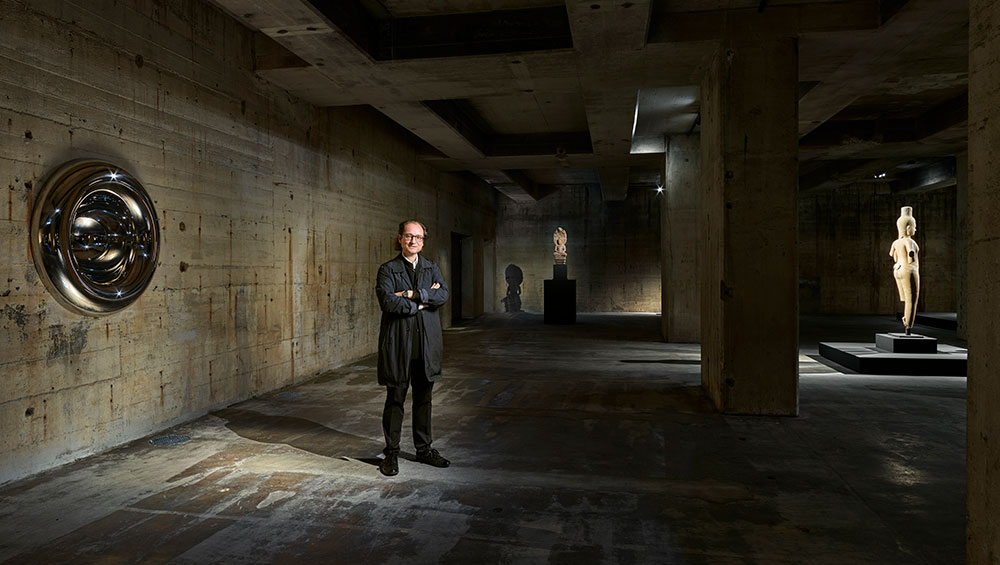
Désiré Feuerle inside The Feuerle Collection. Anish Kapoor, Torus, 2002, steel and Khmer sculptures, in the background: Adorned Buddha Protected by Naga, Bayon Style, 13th century, polychrome wood. On the right: Vishnu, Banteai Srei Style, 10th century. Photo: def image ©The Feuerle Collection.
by VICTORIA NEWHOUSE
One of the great shared pleasures of my 45-year marriage was viewing, and acquiring, art. But although my husband, Si, and I eventually amassed an important collection of modern and contemporary painting and sculpture, it never occurred to us to create a museum for it.
Why do so many collectors go to great lengths to keep their holdings intact – by donating artworks to a museum and restricting how they should be shown, or by creating their own museum – during their lives and after their deaths? Some of the United States’ most familiar institutions – the Whitney Museum of American Art, the Barnes Foundation, the Walker Art Center and the Huntington Museum of Art – started out privately owned. The Gilded Age (1870s to 1900), which gave birth to those institutions, is currently matched by a similarly prosperous time: 100 million Chinese belong to the world’s 10% of richest people, as do 99 million in the US. By 2018, 46.8 million people around the world were millionaires.
The rationale behind private museums is not purely wealth and success, although generous endowments and succeeding family generations help to ensure the survival of these institutions. Even the tax-free status awarded to the costs incurred by a museum doesn’t compensate for what Nancy Olnick describes as the “incredible passion, enthusiasm and a bit of naivete [needed] to embark on a project like Magazzino” (founded in 2017). Olnick and her husband, Giorgio Spanu, are struggling to maintain this enchanting 1,858-square-metre (20,000-square-foot) exhibition space devoted to arte povera, in the Hudson Valley.
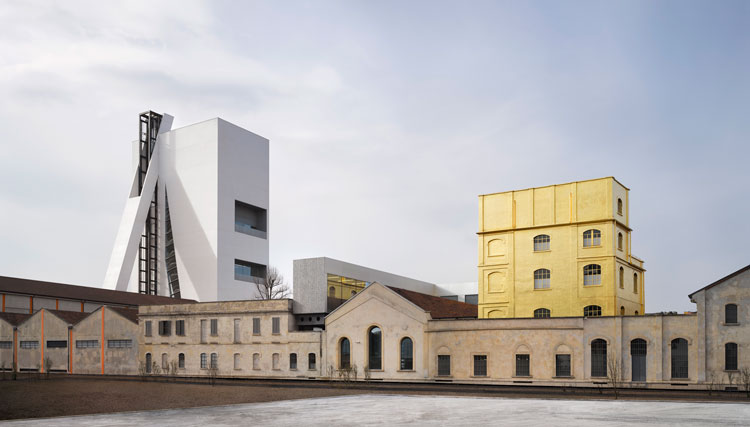
New Milan venue of Fondazione Prada. Architectural project by OMA. Photo: Bas Princen, 2015. Courtesy Fondazione Prada.
For the purposes of this article, I define a private museum as a free-standing building (existing or purpose-built) that houses a specific art collection open to the public. The Prada Foundation museum in Milan (2015), for instance, was inspired by a dramatic existing space, rather than a specific collection. Miuccia Prada and her husband, Patrizio Bertelli, established the Prada Foundation only after a friend remarked in 1993 that sculpture would look well in the post-industrial buildings used for the Prada company’s commercial activities. Now, even with a rich accumulation of objects in renovated and new buildings by the architects OMA, Prada bristles at being called a collector. Rather, she considers the foundation’s art exhibitions in Milan and elsewhere a means of conveying her ideas on subjects such as specific artists, film, politics and neuroscience.
Dodging curatorial whims about what will be displayed in a traditional museum and about administrative preferences, a private museum ensures the exhibition and means of displaying an entire assembly. At the Feuerle Collection (2016) in Berlin, guided group visits (no more than 14 people) cannot enter until they stand in complete darkness listening to a John Cage piano composition. The former gallerist Désiré Feuerle asked John Pawson to refurbish a second world war bunker for his Khmer and Chinese sculpture, Chinese decorative antiques and international contemporary art. A reflecting pond and low light levels contribute to a meditative environment, created at the request of the collector to counter what he considers to be the commercialism of today’s large public museums.
Private museums almost invariably develop activities that go far beyond the exhibition of art, including elaborate programmes of visiting exhibitions, lectures, publications, archives and artists’ residencies. Besides the attraction of showing in a high-profile collection, a residency or other benefit might lure a coveted artist.
A final rationale must include the desirable identity such a venue confers on the collector evermore. Today, the prestige of a private museum can tip the decision of which buyer to accept in a competitive art market. And tomorrow, the museum will serve as a memorial, bringing to the collector an otherwise unattainable immortality.
Private museums have had a remarkable impact on several cities – Miami Beach and Los Angeles, to cite but two – which has encouraged the founding of other such institutions in numerous international venues. The Bass in 1964, the Rubell Collection in 1993 (and now across the street from the Rubell’s new, enlarged venue, teamLab’s Superblue offering “immersive art”), Martin Z Margulies’s Warehouse in 1999, and the Rosa and Carlos de la Cruz Museum in 2009 put Miami Beach on the map. A shared scepticism about the inflexibility of committee-run museums played a large part in these collectors’ independent decisions to proceed on their own rather than pool their resources.
The involvement of these art lovers with their museums has become a way of life, and they alone want to call the shots. One measure of the success of private venues in Miami is the expansion, in 2002, of Art Basel to the Florida city as just its second venue; today, there are as many as 18 yearly art fairs. (Not all initiatives in the city have flourished, however: Ella Fontanals-Cisneros’s CIFO, 2002, folded in 2018, apparently due to a lack of interest in the Latin American art to which the project was dedicated.)
The history of private museums in Los Angeles is markedly different. The film industry was the central cultural presence in Los Angeles for most of the 20th century. The city’s artistic standing began to grow with the Norton Simon Museum (1974, formerly the Pasadena Art Museum), the John Paul Getty Villa in Pacific Palisades (1974), and the Getty Museum in Brentwood (1997). The Broad (2015), a recent addition to this panoply of private venues, has energised the city’s bleak downtown in addition to giving the extraordinary philanthropists Eli and Edythe Broad the control Eli has long sought over exhibition of the 2,000 works in his collection.
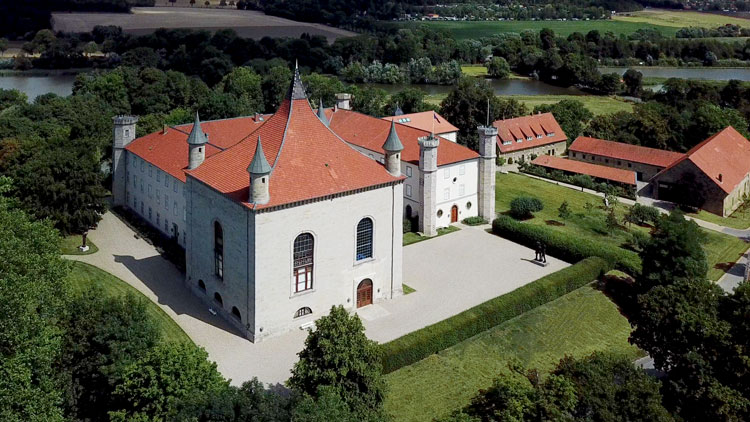
Hall Art Foundation, Schloss Derneburg Museum, Derneburg, Germany. © Hall Art Foundation. Photo: Stephan Hüsch.
One recent museum that illuminates the heterogeneous circumstances behind the creation of private institutions is Andrew and Christine Hall’s Schloss Derneburg Museum. Andrew’s 50th birthday, coupled with the September 11 tragedy, raised “existential questions” for the wealthy former commodities trader and brought home his awareness that “there is more to life than making money”. Hall describes himself as an “obsessive collector”, intent on creating what he calls an “immersive experience”.
Stimulated by an interest in MASS MOCA’s preparations for its 2008 expansion, Andrew and Christine set up a foundation in 2007 to make possible the public exhibition of their collection. Even with the collection’s strong orientation towards postwar German art, it is surprising that the Americans chose to locate their museum near Hildesheim, Germany, in artist Georg Baselitz’s former home.
An 18th-century dairy farm in Vermont served as a dry run for the more ambitious renovation of the 17th-century monastery and surrounding park in Germany, which they acquired in 2006. Since then, the Halls have acquired the domaine buildings, which they are now renovating to create additional exhibition space, a research library, a restaurant and, eventually, a hotel. When completed, this will give them close to 10,000 square metres of exhibition space. The Halls’ pairing of art and nature follows an example set by the late Karl-Heinrich Müller with his Museum Insel Hombroich (1997) near Dusseldorf, Germany, where pavilions containing art dot the landscape. The couple is counting on their two children and four grandchildren, with the help of a substantial endowment, to ensure their legacy. Currently, their daughter-in-law, Maryse Brand, directs the Hall Art Foundation along with an advisory board.
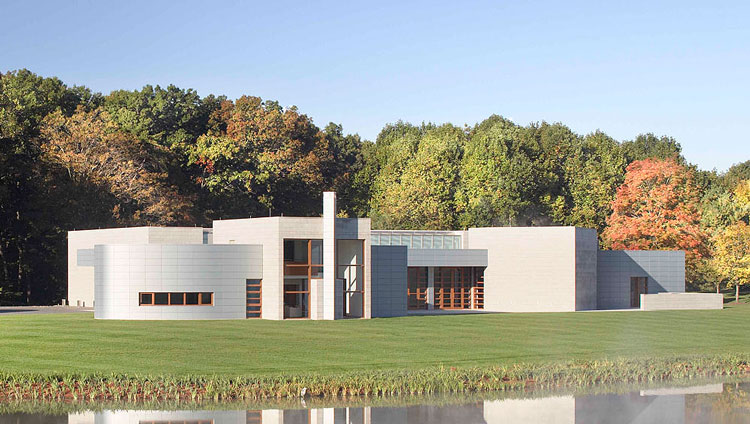
The Gallery. Photo: Scott Frances. Courtesy: Glenstone Museum.
Mitchell Rales and Emily Wei Rales, too, are harmonising art and nature in what they call a “holistic experience” at their property Glenstone in Potomac, Maryland. For Rales, as for Andrew Hall, it was a profoundly unsettling emotional experience – a helicopter crash in Russia in 1998, in which a fellow passenger was killed – that inspired the creation of the pair’s private exhibition space. Shortly after this incident, Rales initiated plans to turn his property (currently about 300 acres, with landscape design by Peter Walker and Adam Greenspan) into an exhibition compound. Mitchell commissioned Charles Gwathmey to design a 2,787 square metre museum (2006); he and Emily, a respected Canadian-born art curator, installed the artworks. The couple, who married in 2008, needed more room for the museum’s growing collection and appointed Thomas Phifer to add a sequence of transparent galleries comprising 4,645 square metres of exhibition space (2018).
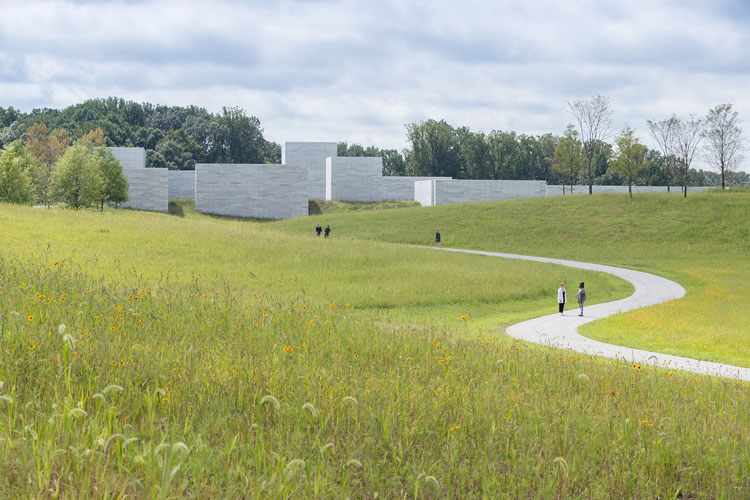
Glenstone. Approach to the Pavilions. Photo: Iwan Baan. Courtesy: Glenstone Museum.
The Raleses were inspired by the Louisiana in Denmark to embed Glenstone in the natural environment, but their model for the use of the space and the quality of the art was the Frick Collection in New York City. Both museums set great works of art in unusual contexts – a home at the Frick, monographic galleries and landscape at Glenstone. Coincidentally, it was also a trauma for businessman Henry Clay Frick – the death of his daughter – that triggered his turn to collecting art.
No museum provides a more successful context for its holdings than the Neue Galerie in Manhattan (2001). Ronald Lauder looked to the Wallace Collection in London, the Jacquemart-André in Paris, and the Frick as models for the renovation of an elegant Carrère and Hastings’ mansion. “Each one of these museums represents a special theme,” he explains, which also summarises his intention for the Neue Galerie, dedicated to 20th-century German and Austrian art and design. Lauder conceived an exhibition space that would reflect the period when the art was made (1900-39) together with the art dealer Serge Sabarsky, an expert in German expressionism and a friend of 30 years. Sabarsky died in 1996, but Lauder continued to pursue the idea of a historically appropriate museum with architect Annabelle Selldorf. In the late 1990s, Lauder was MoMA’s board chairman: he points out that, unlike MoMA, the Neue Galerie had no budget limitations or committee involvement. “MoMA doesn’t touch it,” he says.
Unlike the west, China has no enduring museum tradition, nor does it have any longstanding rules or regulations concerning museums and the foundations often associated with them. Historically, the closest thing to communal viewing of art in China occurred among the early 17th-century intellectuals known as literati, who met regularly to enjoy one another’s collections of painting and poetry. The nation’s museums have grown in number from 21 in 1949 to 5,100 in 2019, though it is evident, in comparison with the more than 35,000 active museums in the United States, that China still has a way to go.
When China began to open up in 1979, after 30 years of isolation, the government allowed construction of residential or commercial space only with the inclusion of a cultural facility, a requirement that helps to explain the creation of more than 850 private museums, 68 of which are for contemporary art, in the last two decades. Yet building a museum as a real estate strategy is not necessarily a practical cultural strategy, and many empty shells, referred to commonly as “mosquito museums”, were the result.
Sotheby’s well-publicised sale of Chinese contemporary art on 31 October 2004, in Hong Kong was a game-changer. The first sale to be so designated, it surpassed all expectations, bringing in US$2.9m, almost twice the estimated value. Between 2003 and 2007, global sales of Chinese art increased by 200%; collecting in the country itself began in earnest around the time of the 2008 Beijing Olympics. Because government-run museums do not display the contemporary art created during China’s politically turbulent 1960s and 1970s, this era provided fertile ground for less ideological exhibition spaces.
Numerous well-to-do collectors in China have installed their holdings in buildings that are open to the public, often without charge. Their motivations are similar to those of art lovers elsewhere: to compensate for a dearth of museums in a particular region, to raise public awareness of contemporary art, and to share enjoyment of their possessions with others. Less altruistically, these art patrons wish to show off their riches, to increase their standing with artists and galleries, to boost the prices of contemporary Chinese art, and to use their museums to promote their businesses (such as rival luxury goods and fashion purveyors Bernard Arnault in Venice in 2006 and François Pinault in Paris in 2014). In Hong Kong, entrepreneur Adrian Cheng’s K11 Art Mall (2009) follows this model, interspersing artworks among commercial retailers.
The prominent Chinese artist Xu Bing calls attention to another, more profound rationale underlying the establishment of private museums in his country by collectors. “Deep down in their hearts there is always a sense of reverence for culture,” he says. This attitude makes the creation of a museum “a dream come true”.
In 2002, the Today Art Museum in Beijing became China’s first non-profit, non-governmental art museum to open and remain operational. It was founded by Zhang Baoquan in a building of more than 2,500 square metres, designed by the architect Wang Hui. Realising that foreign funding was needed to maintain the museum, Zhang eventually added pieces by international artists to his contemporary Chinese works. In fact, funding remains a problem for almost all private museums in China.
Budi Tek, the Indonesian-Chinese founder of the Yuz Museum (2007) in Shanghai, has attracted international attention thanks to his plan to partner with the Los Angeles County Museum of Art. Diagnosed in 2015 with pancreatic cancer, Tek is attempting to ensure that his more than 1,500 East Asian objects will remain intact in his 9,000-square-metre former aircraft hangar in the West Bund Cultural Corridor in Shanghai and in Hong Kong. Tek will turn the ownership of his Chinese holdings over to a Hong Kong foundation that will be governed by the Yuz Foundation and LACMA.
The Long Museum is one of the best-known privately run art venues in China. In 2012, Liu Yiqian Liu and his wife, Wang Wei, opened a huge building designed by Atelier Deshaus in Shanghai’s new Pudong district. The institution exhibits traditional Chinese art together with Wei’s “Red Classics”, or art from the era of Mao Zedong. In 2014, the couple commissioned a second museum across the Huangpu River in the West Bund, this one for contemporary art. Like the Guggenheim, the Louvre, the Pompidou, and several others in China, the Long Museum has expanded by means of subsidiary branches. A third affiliate opened in 2016 in Chongqing. Liu selected Chongqing, he says, because he wants to bolster culture there.
The collector dismisses many of the new private museums, noting that they do not share his “pure” intentions. Liu participates in running the Shanghai venues and dismisses the idea of sharing management with a foundation: “I just like to collect by myself and make decisions by myself,” he says. While the couple is trying to generate spaces that equal those of state-of-the-art museums worldwide, it is questionable whether the unconventional, largely unprofessional running of their venues can achieve this goal.
The Belgian collectors Guy and Myriam Ullens opened the Ullens Center for Contemporary Art in Beijing in 2007 after failing to find a European venue willing to exhibit their important collection of contemporary Chinese art. Guy expressed his wish to “give back” to China the pleasure he derived from the country’s culture. The venue operated unlike many other museums: it did not prioritise the collection, which is gradually being sold, instead becoming a Kunsthalle for changing exhibitions. In 2017, the Ullenses sold the UCCA to venture capitalists, which have added two additional locations.

He Art Museum, located in Shunde, Foshan, Guangdong Province, China. Image courtesy of the He Art Museum.
The He family of Shunde, in the Pearl River Delta, has been collecting art since 2000, but only in about 2016 did they begin to think about building a museum in their hometown, where their business is headquartered. The Hes wish to preserve aspects of the local culture of the former province of Canton influenced the four-storey circular building they commissioned from Pritzker Prize-winner Tadao Ando. Ancient Chinese cosmology and philosophy also play a part in the design. The Hes aspire to a heritage, modelled on the Rockefeller family, that encapsulates the family’s spirit and will survive from generation to generation.
Collectors who have built their own museums generally attach great importance to their architecture. Now the digital realm offers new opportunities to individuals and families who seek innovative practices through which to maintain and display their holdings. One of these is the permanent online presence created by Paris-based Dominique and Sylvain Levy for their stunning collection of contemporary Chinese art. Unable to afford the space or the cost of managing a bricks-and-mortar museum, the couple, looking to the conceptual models of Duchamp and Malraux, commissioned an elegant website for their holdings, which they strictly limit to 350 large-scale objects.
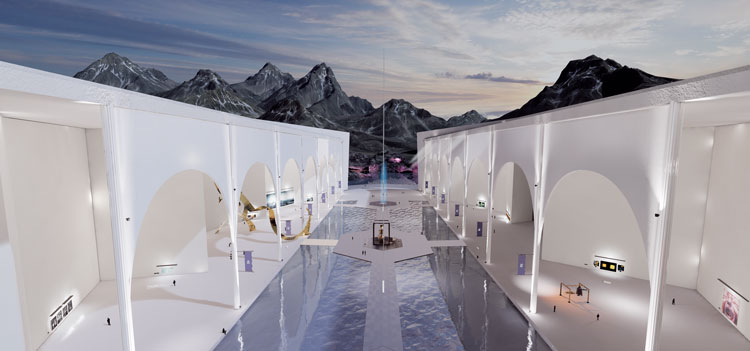
dslcollection. Overview of the collector's virtual museum with artworks installed. Image @ Monochrome-DSLcollection.
They refer to their dslcollection, which appeared in 2005 and has since attracted 92 million viewers, as the “Nomad Museum, a platform of ideas”. The Levys consider traditional presentations outmoded in their failure to connect with a wide public. Not for them are the straightforward online displays that have been used in recent decades to show art; rather, they call for contextual presentations such as one in which selected works appeared as if installed in Paris’s Grand Palais. Their programme also includes electronic and traditional publications.
Digital games and installations, many in contextual settings, have become prevalent in even the most conservative institutions. Early this year, for example, the Metropolitan Museum presented, with Verizon, The Met Unframed, a set of digitally rendered galleries and augmented reality artworks. I was curious about whether the Levys had considered their project in relation to the importance attached by Walter Benjamin to the aura of the object. Their response? “One experience is not better than the other: they are different.”
• For information and quotes, I am indebted to Nancy Olnick, Miuccia Prada, The Fifth BMW Art Guide by Independent Collectors (2020), Jeffrey Deitch, Mera Rubell, Martin Z Margulies, Rosa and Carlos de la Cruz, Joanne Heyler, Andrew Hall, Mitchell and Emily Wei Rales, Ronald Lauder, Snapshot: Independent Investigative Interviews on Chinese Contemporary Private Museums by Shaun Wang (2017), Zhongguo Minying Meishuguan Yunying ji Choujian Yanjiu (Research on Operation and Planning of Chinese Private Art Museums), edited by Alex Gao (2020), Xu Bing, Andrew Ruff, Philip Tinari, Shao Shu, and Sylvain Levy.